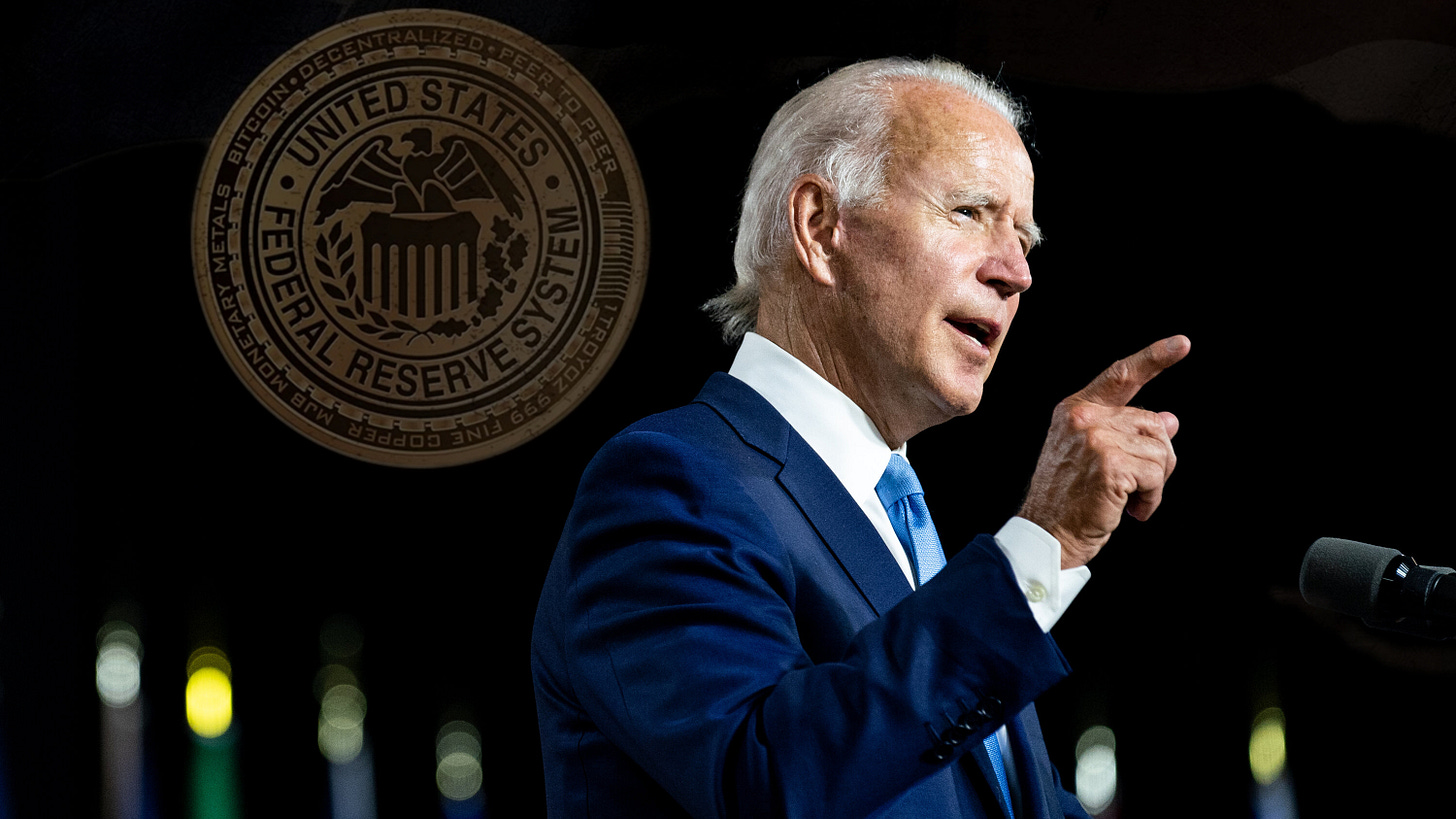President Biden has "concerns" about a form of currency used by a niche of the population, but believes that its nationalized form that subjects an entire population - and beyond - is the answer.
Time Stamps:
Introduction (0:00)
Strong Steps Are Being Taken (2:24)
The Highest Urgency Because, Issues (8:27)
Where Did the Plot Begin? (11:33)
From the Junkyard to Your Junk Mail (18:13)
Alice Gives Bob a Coin (21:56)
The Steelman Speech For Bitcoin (25:54)
Did the Deep State Create Bitcoin? (27:53)
Strong Steps Are Being Taken
In 2022, citing a “dramatic growth in markets for digital assets, with profound implications for the protection of consumers, investors, and businesses,” President Joe Biden issued Executive Order 14067—Ensuring Responsible Development of Digital Assets.
After observing the milestone of non-state digital assets reaching $3 trillion in value a of November 2021, the document quickly cuts to the potential implementation of central bank digital currencies (CBDCs) across the globe.
According to the Atlantic Council's Central Bank Digital Currency Tracker:
134 countries & currency unions, representing 98% of global GDP, are exploring a CBDC. In May 2020 that number was only 35. Currently, 68 countries are in the advanced phase of exploration—development, pilot, or launch.
While Biden's Executive Order acknowledges that “many activities involving digital assets are within the scope of existing domestic laws and regulations,” he cites “inconsistent controls to defend against certain key risks” as a justification for the US government to intervene.
The United States has an interest in responsible financial innovation, expanding access to safe and affordable financial services, and reducing the cost of domestic and cross-border funds transfers and payments, including through the continued modernization of public payment systems. We must take strong steps to reduce the risks that digital assets could pose to consumers, investors, and business protections; financial stability and financial system integrity; combating and preventing crime and illicit finance; national security; the ability to exercise human rights; financial inclusion and equity; and climate change and pollution.
The language of “strong steps” and a host of issues impacted by the trade of digital assets should suggest that political action hardly ends with an Executive Order as a mere statement that the nation's top economists are simply exploring the phenomenon of cryptocurrency and may recommend a few tweaks here and there to improve upon the security concerns it presents.
To be sure, plenty of lip service is paid to a non-threatening vision of custodianship. There's plenty of ear-tickling on “safeguards,” “responsible development,” “privacy,” and “human rights.” A familiar appeal is made for applying the principle of "same business, same risks, same rules."
This all sounds like basic oversight; the kind of functions necessary to pursue in any social order. But in laws both good and bad, assurances are all part of the routine. They present us with many clues as to how a public official will wiggle out of otherwise pointed questions and criticisms.
The Highest Urgency Because, Issues
“[C]limate change and pollution” was also mentioned.
If cryptocurrency mining for a niche market is causing pollution anywhere on the radar, how bad will it become for a CBDC? Haven't we been through this with the NSA's Utah Data Center, which uses over a million gallons of water a day to cool their computer systems?
Theres no problem acknowledging the “national security risks posed by [the] misuse of digital assets.” At least, not in of itself. But one doubts this is simply a night watchman's vision, which would be reasonable enough. The pretext of “national security” all too often entails a quest to exercise broad executive powers that risk the rubber-stamping of the judicial system. Congress has the tendency to pass the buck to the President, as they've done with the power to declare war and determine what our “national interests” are.
Which brings us to perhaps the most troubling part of the order, Section IV, where under no uncertain terms, a CBDC is set out in the “highest urgency” for research and development.
The policy of my Administration on a United States CBDC is as follows:
(i) Sovereign money is at the core of a well-functioning financial system, macroeconomic stabilization policies, and economic growth. My Administration places the highest urgency on research and development efforts into the potential design and deployment options of a United States CBDC. These efforts should include assessments of possible benefits and risks for consumers, investors, and businesses; financial stability and systemic risk; payment systems; national security; the ability to exercise human rights; financial inclusion and equity; and the actions required to launch a United States CBDC if doing so is deemed to be in the national interest.
And there's that magic mantra, “the national interest.” A term given the stamp of approval in the minds of all but the most suspicious critics of governmental activity. Preceded by a list of noble-sounding assessments, it must have the teeth to chew off any reasonably held reservations. After all, who doesn't want “financial stability?”
Did the CBDC suddenly qualify for “the highest urgency on research and development efforts?”
Very shortly, you'll see how this objective has its roots laid out in the mid-1990s by none other than the NSA.
Where Did the Plot Begin?
Michelle Makori of Kitco News conducted an interview with Lynette Zang, who repeatedly hypothesized that Bitcoin has served as a Trojan Horse for a central bank digital currency. When pressed for evidence, Zang cited the NSA's 1996 report entitled How to Make a Mint.
The references are provided, which is all the more revealing. Writings related to cryptology and its potential relationship with a digital currency span back to 1988, from what we can extrapolate.
From the Introduction:
With the onset of the Information Age, our nation is becoming increasingly dependent upon network communications. Computer-based technology is significantly impacting our ability to access, store, and distribute information. Among the most important uses of this technology is electronic commerce: performing financial transactions via electronic information exchanged over telecommunications lines. A key requirement for electronic commerce is the development of secure and efficient electronic payment systems. The need for security is highlighted by the rise of the Internet, which promises to be a leading medium for future electronic commerce.
Electronic payment systems come in many forms including digital checks, debit cards, credit cards, and stored value cards. The usual security features for such systems are privacy (protection from eavesdropping), authenticity (provides user identification and message integrity), and nonrepudiation (prevention of later denying having performed a transaction).
The type of electronic payment system focused on in this paper is electronic cash. As the name implies, electronic cash is an attempt to construct an electronic payment system modelled after our paper cash system. Paper cash has such features as being: portable (easily carried), recognizable (as legal tender) hence readily acceptable, transferable (without involvement of the financial network), untraceable (no record of where money is spent), anonymous (no record of who spent the money) and has the ability to make "change." The designers of electronic cash focused on preserving the features of untraceability and anonymity. Thus, electronic cash is defined to be an electronic payment system that provides, in addition to the above security features, the properties of user anonymity and payment untraceability.
From the Junkyard to Your Junk Mail
Recently, we covered tech corporatism, and how it followed an age where governments lagged behind technologically to the point of ridicule. Even the FBI at the time “was not quite computerized,” to quote Eric O'Neill, from his recounting on American Scandal, when he was chosen to assist inbringing down their notorious mole, Robert Hanssen. O'Neill was chosen as a surveillance operative at the time because, in addition to possessing expertise in working undercover, he knew “how to turn a computer on.”
While the government had an embarrassing lag technologically, they possessed remarkable foresight when it came to an electronic payment system. And in contrast to Paul Krugman's own embarrassment, they saw the Internet's promise as “a leading medium for future electronic commerce.” Insofar as the fax machine goes, if you were there, you know.
At face value, it does seem strange that this template for a cryptocurrency would be modeled after cash, for some of the reasons cited. “Untraceable?” “Anonymous?” Maybe it seemed that way in an era where intelligence memoes were still done on a typewriter. But cutting forward, internet access makes your inputs vulnerable to anyone with the ability to monitor your keystrokes, and that emphatically includes the intelligence community.
And how about the push for a cashless society? Bank of America CEO Brian Moynihan publicly declared his desire for just that in 2019. And he's not alone.
Journalist and author Brett Scott observes four primary institutional “conspirators” as follows:
The Banking Sector - “They can get data and fees via digital payments.”
Payment Card Services - “Every cash transaction is a transaction they're not making fees from.”
The Fintech Sector - “Cash has an offline form of money that it doesn't gel well with automated systems.”
Governments - “I'd say, hey, we can watch payments more easily if they're digital, so let's attack the paper cash system.”
Alice Gives Bob a Coin
Here’s another passage from How to Make a Mint:
In general, electronic cash schemes achieve these security goals via digital signatures. They can be considered the digital analog to a handwritten signature. Digital signatures are based on public key cryptography. In such a cryptosystem, each user has a secret key and a public key. The secret key is used to create a digital signature and the public key is needed to verify the digital signature. To tell who has signed the information (also called the message), one must be certain one knows who owns a given public key. This is the problem of key management, and its solution requires some kind of authentication infrastructure. In addition, the system must have adequate network and physical security to safeguard the secrecy of the secret keys.
Coinbase, a prominent cryptocurrency exchange service, employs very similar language as the NSA document when addressing the issue of a digital signature.
Digital signatures are almost impossible to forge because they are based on number theory. In what is called “public key cryptography”, users own a public key and a private key, which form a pair. Public key cryptography uses encryption to guarantee security and protect sensitive key information.
Perhaps that's just information being information. But it's downright eerie to see the names “Bob” and “Alice” appear in both the NSA document and the Coinbase article, as though it's “copy-pasta,” or as though it had the same writers involved.
From How to Make a Mint:
[A] payer or consumer, whom we will name Alice. [A] payee, such as a merchant. We will name the payee Bob. [A] financial network with whom both Alice and Bob have accounts. We will informally refer to the financial network as the Bank.
And here is how a payment transaction is explained in that document:
Alice gives Bob the coin.
Bob contacts Bank and sends coin.
Bank verifies the Bank's digital signature.
Bank verifies that coin has not already been spent.
Bank consults its withdrawal records to confirm Alice's withdrawal. (optional)
Bank enters coin in spent-coin database.
Bank credits Bob's account and informs Bob.
Bob gives Alice the merchandise.
And now, we return to the Coinbase article:
For digital signatures… Alice uses her private key in the signing algorithm to link a signature to her message and public key. No one can derive Alice’s private key, or forge a valid signature for her, using only her signature and public key. However, anyone who knows Alice’s public key can easily verify that the message was signed by her private key.
The Steelman Speech For Bitcoin
Now, we've beaten up on the crypto world quite a bit. So we're going to take in the steelman argument for a minute or so.
Research Director Peter Van Valkenburgh of Coin Center pitches Bitcoin as a revolutionary currency that requires no middleman in sending and receiving units of value, thus ultimately no corporate intermediary between sender and recipient, making way for a public (but non-state) trading infrastructure.
In an age where cancel culture has in some cases been enforced against certain individuals for holding controversial political views, this feature seems like a godsend.
But does it withstand the scrutiny? Or is it in fact a Trojan Horse for a state-controlled CBDC that serves the very institutions that private cryptocurrencies were promoted to escape?
Did the Deep State Create Bitcoin?
To the chagrin of most Bitcoiners, it has been alleged that its designer, Satoshi Nakamoto is actually the NSA in disguise. Other suspicious minds suspect “Satoshi” refers directly to the CIA.
The name of Bitcoin’s pseudonymous creator, Satoshi Nakamoto, can be interpreted as a reference to the U.S. spy agency. Nakamoto, loosely translated from Japanese, means “central,” while the name Satoshi means “intelligent.”
Some key points referenced in my presentation are confronted by a popular YouTube video from Bitcoin University called Did the NSA Create Bitcoin?
There are now too many connections to deny a clear link, or even that Bitcoin has in a sense become “part of the system” it was once pitched as an escape from. But even with that acknowledgement, plenty of Bitcoiners in the responses simply doubled down.
One comment reads:
If the government created a global currency exit, with permissionless, trustless, transparent transactions on an immutable blockchain & gave users the private keys; then l'd say my tax dollars were well spent! Literally the governments greatest contribution to mankind.
Here is another response:
The gov also invented the internet and a lot of other tech we use for peaceful reasons. So if they created it it doesn't matter. What matters is it's there and open source and the full node network effect is unstoppable at this point.
To be sure, there were also plenty of comments suggesting that the government lacks the intelligence to develop such a phenomenon as cryptocurrency. But it is here we return to Hans-Hermann Hoppe's observation that to reach your way to the top in the present system, “you must be an intelligent bad guy.”
And if that holds water, and a CBDC is now inevitable, let's ask one more time: was Bitcoin - and other such cryptocurrencies - a Trojan Horse for the central bank digital currency?
And is this an irreversible jujitsu move that has turned the sharpest dissent on its head?
See Also:
External Resources:
Executive Order 14067—Ensuring Responsible Development of Digital Assets by President Joe Biden
Central Bank Digital Currency Tracker by the Atlantic Council
Utah city ordered to release NSA center water usage numbers by the Associated Press
How to Make a Mint by the National Security Agency
FBI Agent Turned Russian Spy: Going Undercover, Part 5 by American Scandal
Understanding the War on Cash by Chris Hill
Why digital signatures are essential for blockchains by Coinbase
Big Questions: Did the NSA create Bitcoin? by Felix Ng
Donate to Mr. Menger:
Tip with Buy Me a Coffee
Tip with Cash App















Share this post